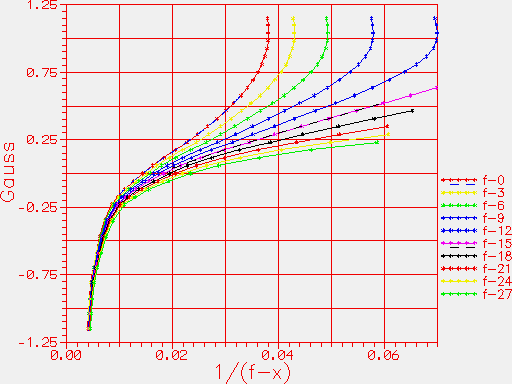
"Lab notebook" web page of Darrel Emerson
These tests describe measurements made on several fluxgate magnetometer
sensors made by Speake & Co., supplied in the USA by
Fat Quarters
Software and Electronics. More information may be obtained
from Erich Kern. I have no personal
connection with either company. The magnetometers are particularly
sensitive, and are designed to measure small fluctuations in the
geomagnetic field. The model FGM-3h is the most sensitive in
the range of sensors available from Fat Quarters Software, and in
fact is so sensitive that it will saturate if aligned N-S along
the Earth's field. It is normally used aligned in the E-W direction,
which is equivalent to measuring the "Y" term of the field; this
is approximately proportional to the magnetic declination D.

| Summary of sensors tested | |
|---|---|
| Sensor #1 | Original FGM-3h, with 3 wire leads |
| Sensors #2, #3 | Second batch, October 1997. 4 pin connections. |
| Sensors #4. #5 | Third batch, November 1997. 4 pin connections. |
| Sensor # | Batch | Change in field/Change in period, Gauss/millisecond | Hz/gamma at 60 kHz |
|---|---|---|---|
| 1 | I | 31.6 | 1.14 |
| 2 | II | 35.95 | 1.00 |
| 3 | II | 35.45 | 1.02 |
| 4 | III | 30.91 | 1.16 |
| 5 | III | 29.95 | 1.20 |
The slope of the fitted straight lines (column 3 in the above table) gives the change of field, in Gauss, required to change the period of the pulse stream from the magnetometers by 1 millisecond. Simple calculus enables this to be expressed in terms of Hz/gamma (1 gamma = 1 nT = 10-5 Gauss). Because the sensor is close to linear in period, not frequency, this sensitivity constant (Hz/gamma) depends on the applied magnetic field, or specifically varies as the square of the sensor's pulse frequency. To make useful comparisons, the sensitivity in Hz/gamma has been calculated assuming a sensor pulse frequency of 60 kHz, which corresponds to nearly zero field for all the sensors and is near the middle of their working range.
The above table shows that sensors of a given batch (#1=batch I, #2 & #3 = batch II, #4 & #5 = batch III) have comparable sensitivity, within about 3% of each other, but that batch 3 is approximately 17% more sensitive than batch 2. With the small number of samples, this is probably over-interpreting the data, but it is interesting to note.
The conclusion is that all sensors are relatively similar, although
there do seem to be small systematic differences between the batches. In terms
of sensitivity expressed as Hz/gamma, on the face of it the most
recent batch is, by a small
margin, the best.
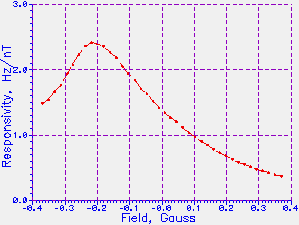
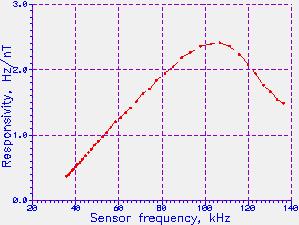
Figure 5 (a) & (b). Responsivity of Sensor #5, vs field and vs frequency
Measurements were made on two FGM-3 sensors. These have been labelled "Sensor #6" and "Sensor #7." The FGM-3 sensors are slightly less sensitive than the FGM-3h, but are capable of measuring up to about +/-0.6 Gauss.
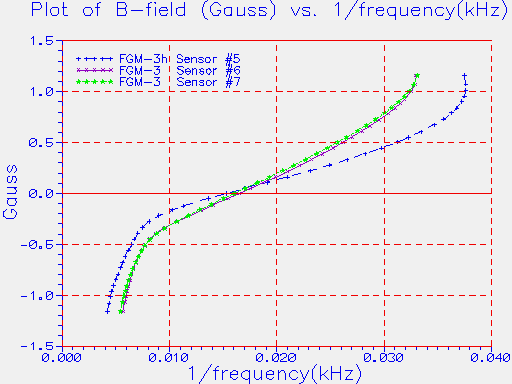
The slope of the above calibration measurements, in the neighbourhood of zero field, is 28.4 gauss/ms for sensor #5 (the FGM-3h) and 47.0 & 49.2 for sensors #6 & #7 (the FGM-3). [Note the smaller the number, in gauss/ms, the more sensitive the sensor.] This makes the average responsivity of the FGM-3 sensors a factor of 1.7 less than that of the FGM-3h.
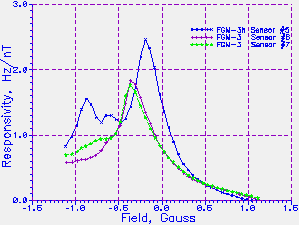
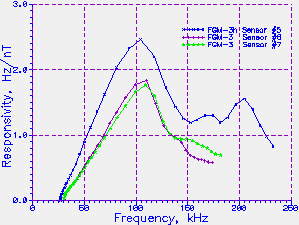
My home is about 10 miles from the Tucson Magnetic Observatory, one of the official USGS observatories. Data from that observatory has just kindly been made available to me. The plot below (Figure 8) shows a comparison of my own data with that from the Tucson Magnetic Observatory for UT date November 5th. This was a geomagnetically unsettled day. My data were calibrated by fitting a 3rd-order polynomial to the calibration measurements for Sensor #1 above, and using the polynomial fit to convert measured sensor frequencies to nanoTesla (1 nT = 1 gamma = 10-5 Gauss).
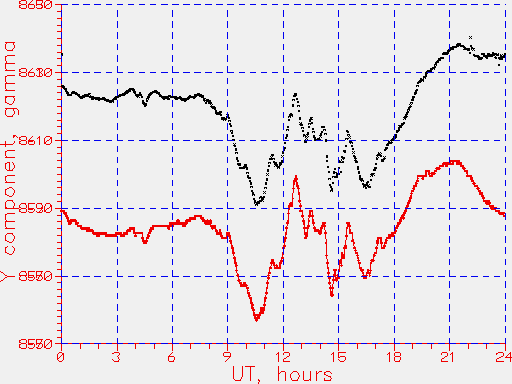
Figure 8. Superposed plots. Total vertical range 100 nT, with dashed horizontal lines every 20 nT
The upper (black) plot shows my own data, sampled nearly every 2 minutes, for UT 0h - 24h on UT date 5th November 1997. My sensor is nearly E-W, so is sampling the Y component of magnetic field. The Tucson Observatory data were supplied as HDZF data, but the D value, in arc min, has been converted to the conventional Y component, using the standard formula (Y=H*sin(D)).
The lower (red) plot shows the data from the Tucson Magnetic Observatory, sampled every minute. The total range of the plot is 100 nanoTesla (nT), with grid lines drawn every 20 nT. There is an arbitrary DC offset applied to the plots, to be able to put them on to the same graph. When the above plots were made, my convention of sign of the field was reversed; the two traces are matched, but both are inverted with respect to usual practice.
As can be seen, there is excellent agreement between the data sets. The Tucson Magnetic Observatory is about 10 miles from my home, so the earth's magnetic field in the two locations should be nearly identical. My own data (the upper plot) were calibrated with a home-made solenoid, putting a known current through the coil. It seems as if my calibration may be a few percent low, but I find the agreement quite remarkable.
The only significant difference is in the last 4 or 5 hours of the UT day. The Tucson Observatory data show a gradual decline in field, ending up at 24h very close to the value measured at 0h. My own data stay more constant, ending up about 10 nT higher in measured field at 24h, compared to the 0h measurement. My guess is that this is a temperature effect. Although I have tried to stabilize the temperature of my sensor as far as feasible, there is bound to be some residual effect.
All in all, I'm delighted with this comparison.
The upper trace shows the data from the Tucson Magnetic Observatory, while the lower trace shows my own measurements with the FGM-3h sensor. (An arbitrary DC offset has been applied to be able to show the two traces on the same plot without confusion). The Tucson Magnetic Observatory data were sampled every minute, but my data were only sampled about once every 2 minutes. Each day's data is shown in a different color. Again, there is outstanding agreement between the two data sets. The first two days (326-327) show magnetic storm conditions, which have died down to reveal the normal quiet field diurnal variation for about the last 10 hours of day 328. Close inspection does reveal some minor differences, but I do not know if these are real differences (I am about 10 miles from the Tucson Magnetic Observatory, and the physical alignment of my sensor is probably a few degrees different from the true E-W of the Y component of field), or small drifts in the sensor's output. The measurements track each other within about 10 nT, which I find quite remarkable; even changes as small as 1 nT generally correspond in the two datasets.
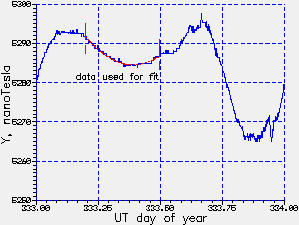
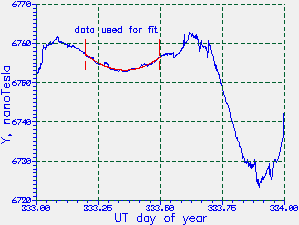
| Dataset | # samples from day 333.2 to 333.5 (7.2 hours) |
RMS Residual, gamma or nT |
|---|---|---|
| (1) USGS Tucson Mag. Obs. | 433 | 0.326 |
| (2) FGM-3h Sensor #1 | 194 | 0.311 |